 |
||
|
||
| ||
Well, you can say that the guys writing the reviews on motherboards are a bit touched: first they published an article about the absolutely unnecessary Pro266. Now they are going to tell us about too expensive i850 based boards coupled with an outdated Socket-423. Well, but let me justify myself. You must remember that on 27 August Intel announced a new Pentium 4 2 GHz which is now has a 600 MHz lead over the AMD Athlon!!! Recently a processor with such a clock speed was considered unpurchasable for the most of users. At just a little more than a year the frequency of Intel processors has doubled: if lately the company's flagship was Pentium III 1 GHz, now the palm belongs to the Pentium 4 2 GHz. So, what? Well, now the lower models of the line having rather good overclocking potential and high performance in the class where this performance is highly critical cost just a bit more than a hundred dollars. At the same time, these models are based on the Socket-423, thus allowing us to assemble a system on reliable and debugged mainboards the price of which is comparable to the AMD760 based boards. The RDRAM memory, however, becomes the most expensive component of such system. Thus, the Pentium 4 based system on the Socket-478 and with SDRAM support will be comparable in price with the above mentioned system. But while the first system can boast of the higher bandwidth of the RDRAM and it has withstood the test of time, the second system has a higher processor frequency. The second system might seem to be preferable since the processor is faster, the Socket is better, the chipset is newer. At the same time, Intel has heaps of old processors for the Socket-423 at 1.3 to 1.8 GHz at their stores. So, what do you think Intel will do to get rid of old CPUs? Undoubtedly, there will be a lot of gift bundles of processors and RDRAM memory offered at cut rates. So, what board do you want to such a combination?
DFI WT70-EC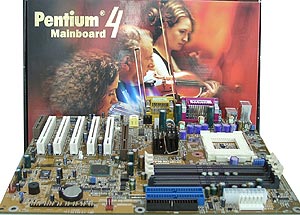 In the stylish box you can find, apart from the board, a brief installation manual in 4 languages, an 80-conductor ATA66/100 cable, 2 C-RIMM modules, an FDD cable, a mount for a cooler and a CD with drivers and utilities. Among the programs there are only Adobe Acrobat Reader and PC Cillin2000. 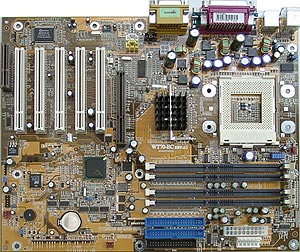 The layout is rather good. There are 3 LEDs: one signals that PCI slots are under tension, the other two inform about the voltage on the memory. The north bridge (MCH) is equipped with a high-profile heatsink which will protect the board from overheating. The protection function is carried out also by 7 750uF and 3 2200uF capacitors. The board has two switches to clear the CMOS, to make the computer awake from a PS/2 mouse or keyboard, or from a USB keyboard. On the board you can find a speaker which can be enabled with another switch. The BIOS based on the v6.00PG from Award will help you change a memory frequency - 300, 400 or Auto, a processor multiplier (which is unfortunately locked in all production processor models from Intel) and to distribute manually IRQ among PCI slots. Well, this board is relatively cheap, works stable and has some configuration possibilities. EPoX 4T2A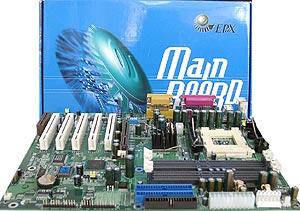 The blue box contains a user's manual, 80- and 40-conductor cables for IDE devices, an FDD cable, 2 C-RIMM modules, a mount for a cooler, a bracket for the rear computer panel with two additional USB ports and a CD with the required software and different programs: PCCillin 2000, Symantec Norton Ghost 6.03, Adobe Acrobat Reader, Boostek utility for overclocking the processor from the Windows and some utilities for system monitoring - from EPoX, VIA and Winbond. 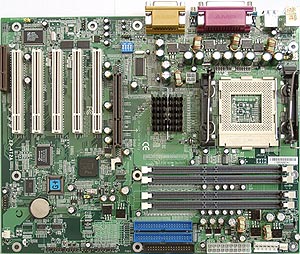 The traditional indicator of POST codes is unfortunately lacking here. Among interesting details you will find an audio chip from C-Media and a clamp on the AGP slot. CD-in and AUX-in are located in front of PCI and AGP slots which will be difficult to reach with the expansion cards installed. The feed circuits contain 12 LowESR capacitors - 8 of 2200uF and 4 of 1500uF. One of the switches allows you to change a base CPU frequency - 100, 103, 105, 108, 110, 115, 118, 120, 122, 125 and 133. In the BIOS, though, this function is absent. The BIOS based on the v6.00 from Award will help you make settings for the memory, AGP bus etc. Besides, the CPU voltage can be changed in 0.025V steps, the AGP bus voltage can be altered in 0.1V steps and the memory voltage can be adjusted as well in 0.1V steps. The price policy of the company allows combining two concepts - "high-efficent" and "cheap" in one computer. MSI 850 Pro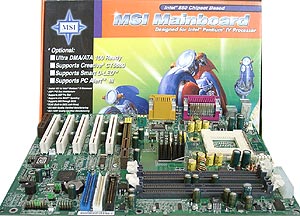 In the florid box we have found the following accessories: ATA66/100 and FDD cables, 2 C-RIMM modules, a mount for a cooler and a sticker with the POST codes description (which are displayed with the D-LEDs). Besides, there is a small booklet with the description of the PC2PC technology, a silvery sticker "Geared by MSI", a calendar, a user's manual and a CD. The CD contains drivers for motherboards and video cards from MSI, .pdf descriptions of almost all MSI boards, Adobe Acrobat Reader, AMI and Award utilities for working with the Suspend-To-Disk function, WinFlash from Award for updating of the BIOS right from Windows, proprietary programs such as LiveBIOS and Fuzzy Logic 3, a PC Alert for monitoring temperatures and fan speeds, MediaRing Talk for online communication, X-Setup etc. 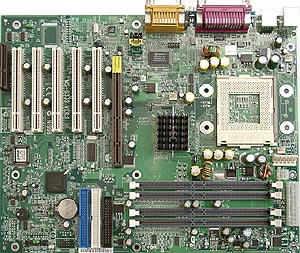 The layout has some imperfections: IDE&FDD connectors are placed at the right angle to the memory slots, i.e. their cables will be twisted, and long PCI cards will be difficult to install. The board has several unsoldered connectors and chips (there is, for example, space for an audio adapter based on the Creative CT5880). Besides, you can find here a built-in speaker and jumpers designed to activate a built-in audio adapter and a speaker and to clear the CMOS. The BIOS based on the v1.24 from American Megatrends Inc. will help you make settings for the chipset and AGP bus and change a CPU multiplier. The board is not of great interest for an overclocker. But if your main goal is a computer which doesn't hang constantly, this board will suit you. AOpen AX4T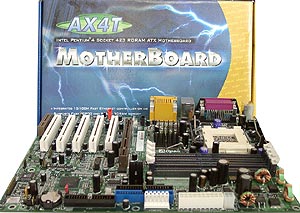 As a rule, AOpen offers two designs of boxes for their boards - for usual and for exclusive models. The today's board is usual, there are a poster with a short installation instructions, ATA66/100, ATA33 and FDD cables, 2 C-RIMM modules, a mount for a cooler and a USB cable for the rear computer panel. One of two CDs contain Adobe Acrobat Reader and descriptions in .pdf. The other has Norton AntiVirus 2000.  The layout is rather good. The only drawback is CD-in located in front of the PCI slots. The AGP Pro connector allows using video cards with increased power consumption. The switches will help you clear the CMOS and increase the FSB frequency from 100 to 133 MHz. The BIOS based on v6.00PG from Award can't boast of a great deal of features. Except a possibility to change a CPU multiplier it has nothing interesting. This stable board with such functional components as integrated network and audio adapter can be recommended for powerful work stations and expensive office computers. ASUS P4T-M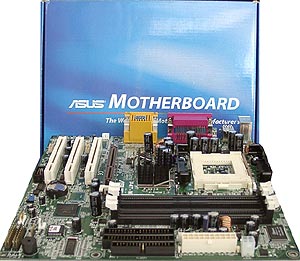 This is the only board of the mATX format on this chipset. The blue box offers you a great deal of accessories: a detailed user's manual, ATA66/100 and FDD cables, a bracket with a serial port and two USB ones, a mount for a cooler, 2 C-RIMMs, chassis for mounting the board in a usual case and a CD. This CD contains a traditional set of programs: drivers for the board, Adobe Acrobat Reader 4.05, PC-Cillin 2000 v. 7.0 from Trend Micro, Power Player SE 5.0, PowerDVD Trial 3.0, VideoLive Mail 4.0 from CyberLink, 3Deep for adjusting the color balance and ASUS's own programs - screensaver, ASUS Update and ASUS PCProbe. 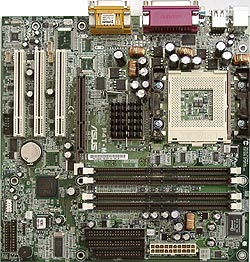 There are several interesting points to be mentioned here. First of all, there is space for the IEEE1394 controller, that is why the second parallel port is taken out of its usual place and is mounted on the rear panel - there must have been IEEE1394 connector. Besides, there is space for a network adapter. On the whole, the board might make difficulties in the course of assembling: it won't be easy to install the memory if a video card is already inserted into the AGP slot. Audio-ins are located in front of the PCI slots but you should account for the format. The feed circuits contain 7 1500uF and 4 1200uF capacitors. Audio connectors are non-standard, that is why you will have to look for a cable for a CD-ROM drive, for example. All settings are hidden in the BIOS - on the board you will find only one jumper for clearing the CMOS. The BIOS is based on the v. Medallion 6.00 from Award and contains a number of settings which are very common among boards. Here you can, for example, choose a memory frequency and a CPU multiplier. Abit TH7-RAID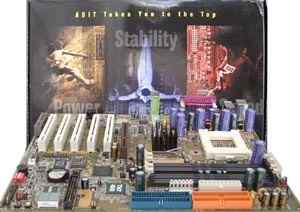 This production sample was packed in a usual dark box. Inside there are such accessories as a user's manual, ATA66/100 and FDD cables, a bracket with a Game-port, a bracket for the rear computer panel, 2 C-RIMMs, an additional thermistor and a CD with software. The set of programs has recently changed: there is a DVD player - WinDVD, Hardware Doctor, Adobe Acrobat Reader and Buzzsoft's programs - SoftCardManager, SoftCopier, SoftPostCard, SoftBulkEmail and a utility for a low-level formatting of hard discs from Award. 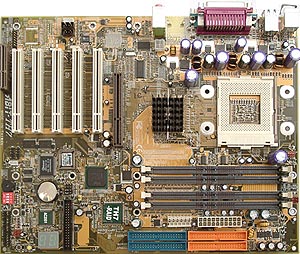 The board is quite convenient. The only disadvantage is position of audio-ins. The board looks like a testing area for the Abit Engineered technology which provides for two 7-segment LEDs so that we know how loading proceeds, power and reset buttons onboard and overclocking stripes. But the latter are, for some reason, absent. Besides, there are 5 4700uF and 10 2200uF capacitors to make the board more stable in an overclocking mode. There are also unsoldered chips of a network and firewire adapters, that is why the board is supplied with a non-standard bracket for the rear panel and a bracket with a game-port. The IDE Raid is a rather cheap and good way to increase the performance of the disc subsystem. The switches will help you enable/disable SoftMenu functions, clear the CMOS etc. The BIOS is based on the v6.00PG from Award and features the SoftMenu technology to overclock the processor. Here you can change a memory frequency (300 or 400MHz), change a FSB speed in 1 MHz steps (from 90 to 156MHz), change a CPU multiplier and Vcore. Besides, you may adjust the AGP bus and distribute interrupts among PCI slots. Such a high overclocking potential of the board helps it to work stable both a t rated and at higher frequencies. Test system
Software
Test results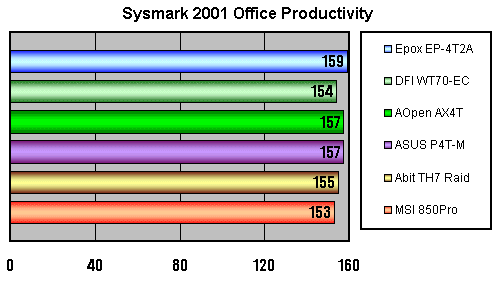 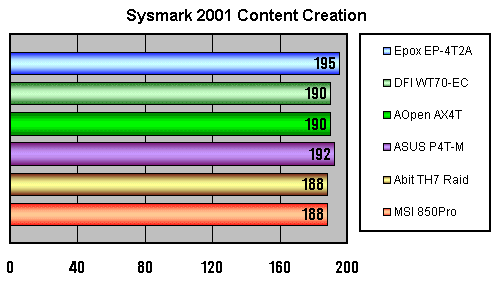 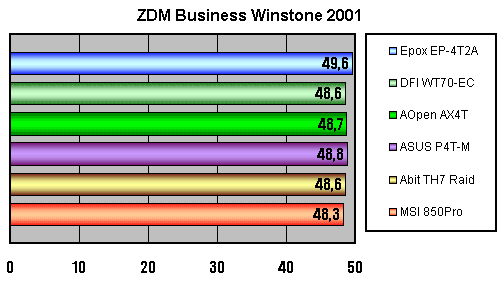  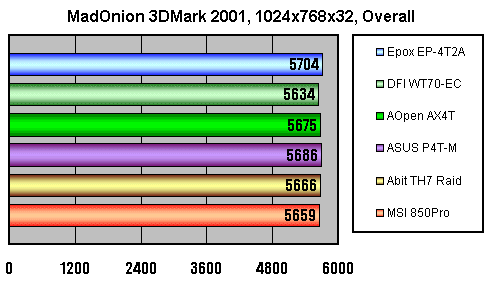 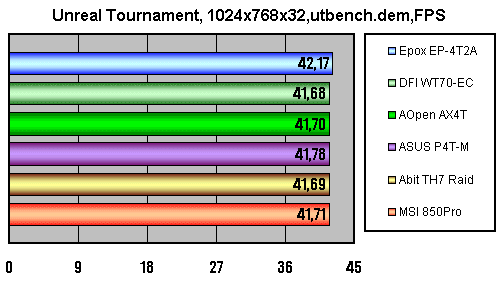 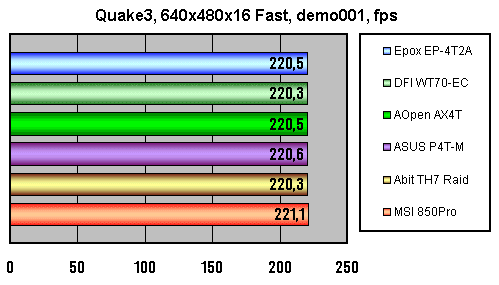 Well, all boards performs equally, so it is quite hard to single out an outsider. The ASUS is just a bit ahead of its competitors, while the palm of supremacy belong to the EPoX 4T2A. So, the leader among i850 boards - P4T from ASUS - now has a strong competitor both in quality and in speed. ConclusionThe corner stone, I think, will be a choice of a platform rather than a
motherboard model. I think that the majority would prefer processors on
a new Socket-478, but those who will take an old version won't lose. The
P4 1.5 GHz Socket-423 + i850 combination will be a good choice, I assume,
during one and a half year more. The progress is so fast that in a year
the Socket-478 may need to be replaced because of a lack of the AGP 8x
or Serial ATA.
Write a comment below. No registration needed!
|
Platform · Video · Multimedia · Mobile · Other || About us & Privacy policy · Twitter · Facebook Copyright © Byrds Research & Publishing, Ltd., 1997–2011. All rights reserved. | |||||||||||||||||||||||||||||||||||||||||||||||||||||||||||||||||||||||||||||||||||||||||||||||||||||||||||||||||||||||||||||||||||||